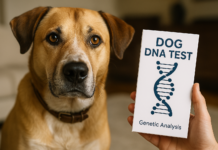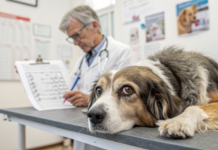Last Updated on December 16, 2021 by Dogs Vets
What is Dog nose hyperkeratosis?
According to a veterinarian, there are several treatment options for dog nose hyperkeratosis.
Hyperkeratosis is a medical term that refers to excessively thick, dry, or cracked skin. Because there is no cure, it is vital to provide your dog with correct treatment in order to keep him happy and healthy.
Known as nasal hyperkeratosis, this condition is caused by an overgrowth of skin cells (keratin) on the surface of a dog’s nose. It is a skin condition that affects the nose.
It’s possible that the skin on the top of your pup’s snout seems rough, thick, and even crusty or cracked as a result of the excessive keratin production.
Veterinary professionals frequently refer to it as idiopathic in origin, which means that we don’t always know what causes it.
The majority of the time, it is not a cause for concern. However, it should not be dismissed out of hand. This is due to the fact that skin that is dry, cracked, or crusted may be more prone to infection. In addition, your poor doggie is feeling the effects of it all!
A dog nose hyperkeratosis is more than just a dry nose; it is actually an accumulation of extra skin development on the inside of the nose as well.
It is possible for dogs to get dry noses for a variety of causes, and they do not necessarily have an overgrowth of skin cells; rather, they have dry skin. Nasal hyperkeratosis is characterized by a dry nose that is considerably more prominent, as well as thicker skin on the top of the snout.
While nasal hyperkeratosis is usually not a major medical problem, it’s always a good idea to consult with your veterinarian so they can provide recommendations and rule out any other conditions that may be associated with the disease.
👉
Keep an eye out for signs of secondary infection at all times.
Check with your veterinarian if your dog’s nose is bleeding, emitting an unpleasant odor, or producing a mucus-like discharge.
It differs from paw pad hyperkeratosis, which is another condition.
It is possible for some dogs that suffer from nasal hyperkeratosis to also develop paw pad hyperkeratosis at the same time.
Paw pad hyperkeratosis, often referred to as footpad hyperkeratosis, is a condition that affects the pads of a dog’s feet. However, not every dog who has one ailment will also have the other.
When dogs acquire an overgrowth of skin cells on their paws, it is frequently related to irregularities in their walking pattern. On the other hand, nothing is known about the underlying causes of nasal hyperkeratosis in canines.
What Are the Causes of a Dog’s Crusty Nose?
A crusty nose is a common problem for dogs who lick their noses too often. When a dog licks its nose, sebum production increases. In this article, we’ll discuss the causes of sebum production in dogs and how you can help your dog.
Symptoms:
1. Coughing
2. Sneezing
3. Nasal congestion
4. Sore throat
5. Itching
What Are the Signs of a Dog with Chronic Hyperkeratosis?
Hyperkeratosis, which is characterized by thickening of the skin that can lead to painful conditions, is a condition in which the skin becomes too adherent to other structures in the body. It can be caused when a dog has an infection or chronic inflammation.
The signs of chronic hyperkeratosis include thickened hair on the ears and tail, redness on the eyelids and paw pads, and dry flakes around the eyes. The condition is often seen in dogs with dry skin issues like allergies or those with itchy skin.
It can also be seen in dogs that live outdoors for long periods of time with no access to water or have been groomed excessively.
How to Prevent A Dog’s Seborrhea Gland from Getting Crusty?
Vet-Tech.com shares how to prevent a dog’s seborrhea gland from getting crusty and what to do when it does.
Seborrhea is one of the most common problems we see in dogs. It is caused by the immune system attacking normal skin cells, which leads to excessive production of oils on the skin.
These oils build up into a thick film that forms a crust over the nose and face, which can be itchy and uncomfortable for your furry friend.
Here are some ways you can prevent seborrhea from getting crusty in your dog:
Keep your dog’s face clean
Use a topical medication that contains sulfur or zinc oxide
Use an oral medication
Use an ointment
Treatment options for hyperkeratosis of the dog’s snout
Although nasal hyperkeratosis in dogs can be controlled, there is currently no cure for the condition. As a result, it is vital to remember that you will most likely need to treat your dog on a frequent basis for the rest of his or her life.
Skin care for your dog comprises rehydrating and moisturizing the skin with warm water soaks and using a soothing ointment on a daily basis to keep the skin healthy. For this purpose, there are also natural balms that are designed specifically for pets.
Do not use topical human medications on your dog’s nose such as hydrogen peroxide, rubbing alcohol, Neosporin, baby oil, or any other topical human medications.
A word or two about CBD oil and coconut oil
However, while many people are turning to CBD oil as a cure-all for all of their pet’s ailments these days, CBD oil is not effective in the treatment of nasal hyperkeratosis.
If you want to put coconut oil to the top of your pup’s nose, that is great. However, Vaseline and the nasal balms that are available are normally thicker and have a more lasting and soothing effect.
Snout Soother is one of our favorite balms, and it’s specifically designed to soothe nasal hyperkeratosis.

Snout Soother® – The Natural Dog Company
We appreciate that all of the ingredients are supplied in the United States. Skin Deep® risk score is incredibly low, which is fantastic, and it boasts natural moisturizing and sunscreen characteristics, which is fantastic.
Amazon is a great place to shop.
Product Ingredients
Сосоnut оil, Kukui Nut Оil, Grарeseed Оil, Сhаmоmile, Оrgаniс Hemрseed Оil, Rоsemаry Extrасt, Sheа Nut Butter, Jоjоbа Оil, Саndelillа Wаx, Nаturаl Vitаmin E,
Snout Soother – It is also available in a convenient sample stick, which is excellent for when you are on the go or if you want to try it out before investing in a lot of quantity..
Instructions on how to use Snout Soother
- Distract your dog by giving him a treat or a toy.
- First and foremost, they should clean their nose (always with water or a vet-prescribed cleanser, NEVER rubbing alcohol or hydrogen peroxide which destroys healthy skin cells and delays healing).
- Make use of your fingertips or a cloth.
- Massage the balm into your skin.
- Make use of a reward
Remember:
- Use it twice or three times a day.
Snout should be used sparingly. Immediately after applying, rub a soothing nose balm or similar yummy treat on their paw, such as peanut butter. Because your dog will lick their paw instead of their nose, the balm will have a chance to work its magic.
Dog nose hyperkeratosis can be caused by a variety of factors.
Dogs with nasal hyperkeratosis are more likely than others to have the condition in their nasal passages.
Several dog breeds, for example, are genetically prone to the condition. Breeds such as brachycephalic dogs and cocker spaniels fall into this category.
English bulldogs, French bulldogs, pugs, and boxers are examples of brachycephalic breeds, which are those with a “smoosh-faced” appearance. Golden retrievers have been known to contract the disease on occasion. It’s also more common in dogs between the ages of six and twelve.
When evaluating whether or not your dog has nasal hyperkeratosis, it is critical to have your pup tested by a veterinarian in order to rule out any other disorders or underlying reasons that may manifest themselves in a similar way.
There are a number of medical diseases that can cause nasal hyperkeratosis-like symptoms (and can even be mistaken for it).
Canine Distemper Virus: Fortunately, this virus is not very widespread these days, because to immunizations that prevent it from spreading.
It is common for dogs with distemper to have a history of severe illness prior to developing nasal hyperkeratosis, which is caused by a bacterial infection.
This is an uncommon, genetic disorder that is more common in Siberian huskies and Alaskan Malamutes than in any other breed of dog, according to the ASPCA.
Superficial Necrolytic Dermatitis: is a type of dermatitis that occurs on the skin’s surface. This is also an extremely uncommon disorder. Dogs suffering from this condition are typically exceedingly unwell with liver or pancreatic illness, as well as having severe skin sores.
Hereditary Nasal Parakeratosis: Another unusual genetic disorder that can be detected in young Labrador retrievers is hereditary nasal parakeratosis.
Pemphigus Foliaceus: This is an autoimmune condition that frequently affects other regions of a dog’s face as well, such as the ears, the area around the eyes, and the higher part of the nose. Pemphigus Foliaceus is also known as “dog’s ear.”
Systemic Lupus Erythematosus (SLE): Another autoimmune condition, SLE is caused by an overactive immune system that cannot be controlled. Dogs suffering from this condition will typically exhibit various clinical indications as well as feeling poorly.
Sandfly-transmitted leishmaniasis: is a parasitic condition that affects the nervous system. If you have recently traveled with your dog to a southern European country in the Mediterranean region, you should notify your veterinarian because this could be a contributing factor.
In light of the fact that these other disorders could create symptoms that are similar to those of nasal hyperkeratosis, it is always a good idea to have your pup checked out by your veterinarian just to be on the safe side. They might want to take a biopsy or do some bloodwork to rule out anything serious.

















